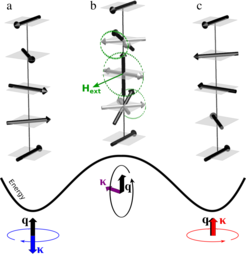Press Release: Room-temperature tetragonal non-collinear Heusler antiferromagnet Pt2MnGa
Antiferromagnets have gained tremendous interest by researchers working in the field of spintronics. In an antiferromagnet the spins align in such a manner that the net magnetization is zero. Antiferromagnets being used as pinning layer in exchange-bias and spin-valves based devices, have now become an active component in spintronics and optical switching devices. The advantage of no stray field due to zero or very small moments and faster spin dynamics of antiferromagnets give advantage for their use in spintronic devices compared with ferromagnetic materials. Therefore, antiferromagnetic spintronics became a rapidly growing field, which is capable of changing modern magnetic storage technology. To make the practical use of antiferromagnets in spintronics requires materials with ordering temperatures above room temperature and small energy barriers between different stable spin configurations. In this respect non-collinear antiferromagnets are extremely promising materials.
In a recent study, scientists from the Max Planck Institute for Chemical Physics of Solids in Dresden demonstrated a non-collinear antiferromagnetism in a tetragonal Heusler compound Pt2MnGa with a high ordering temperature making room temperature applications feasible. Neutron diffraction experiments evidence the antiferromagnet spiral order with a helix propagating along the tetragonal axis. Ab-initio calculations show a purely exchange-based origin of the spiral order with the helicity fixed by the large basal-plane magnetocrystalline anisotropy. The small energy barrier between the degenerate left- and right-handed spirals makes Pt2MnGa a feasible candidate for non-volatile magnetic memories.
SSi / CPfS

Figure caption: Switching of the magnetic helicity using magnetic pulse. Application of the external magnetic pulse Hext perpendicular to the spiral wave vector q causes the precession of local moments (along the dashed green circles), which changes the helicity of a spiral from left-handed screw (a), through the intermediate cycloidal state (b) to the right-handed screw (c). In case of the easy-plane magnetocrystalline anisotropy, the long period of a spiral greatly facilitates reorientation of helicity from K ↑↓ q (blue) to K↑↑ q (red) or vice versa, since the top of the energy barrier between two stable screws (a and c) is a cycloid (b) K ⊥ q (magenta), in which only few atomic planes with magnetic moments orthogonal to Hext acquire the high energy.












